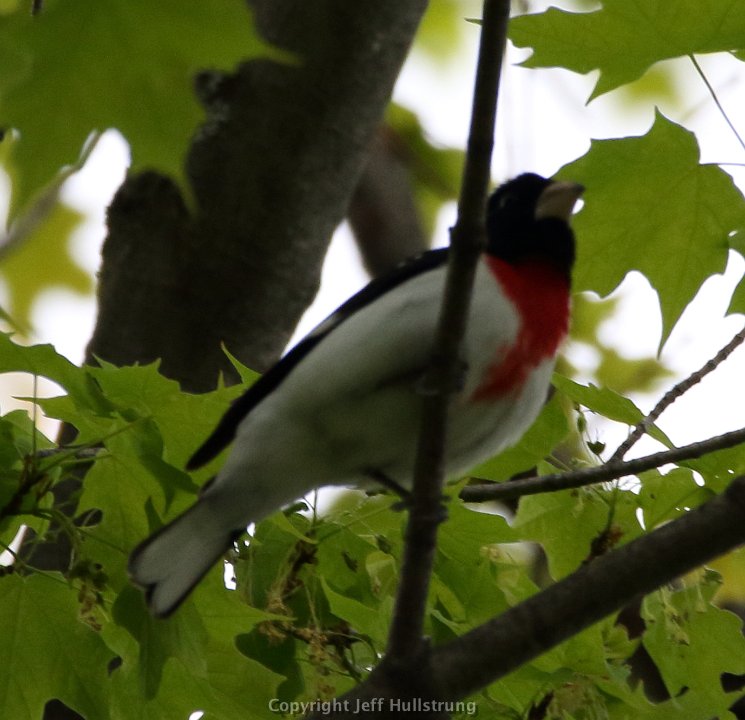Birding at the Woodside Natural Area
by Shirley Johnson
Red-eyed Vireo
Photo: Marc Faucher
One of my favorite places to walk and bird is the Woodside Natural Area at the Winooski/Essex Junction border, just across from the West Dalton Drive entrance to Fort Ethan Allen. From Route 15, your only clue that you are near “Woodside” is a small brown sign next to the west side of the paved road down to the area. The sign reads, “Town of Essex Public Open Recreation Land 68 Acres Acquired by Grant of the US Department of the Interior.” To access the trail, drive down the hill toward the former Woodside Juvenile Rehabilitation Center and park your car on the road next to the entrance gate. The area consists of 52 acres acquired in 1991 by the Winooski Valley Park District and features a loop trail, approximately one mile in length, which meanders along and looks down on a wetland next to the Winooski River. A portion of the trail is located adjacent to the river. Most of the trail is relatively flat, however, there is a set of stairs near one end of the loop and a number of small dips and rises as you walk along.
American Redstart
Photo: Marc Faucher
Although I walk the trail often, in this article I will talk about my observations from a trip to Woodside in June. As I got out of my car, I could already hear Song Sparrows, Mourning Doves, a Gray Catbird, American Robins, and a Veery. I walked through the gate and down the entrance corridor, with tall trees arching over the path, and turned left onto the Woodside Loop. I saw Yellow Warblers and heard the repeated “che-bek, che-bek, che-bek” of a Least Flycatcher perched in the trees above. After I climbed the set of stairs and was on the trail, I noticed there was greenery all around me, but the trail had recently been mowed and there was plenty of room. I remember thinking: “This is summer in Vermont and it’s beautiful!” Walking along the ridge overlooking the swamp, there was a symphony of frogs, Red-winged Blackbirds, and Common Yellowthroats with a Red-eyed Vireo in the solo part. I looked out over the marsh and saw a deer browsing on plants. A White-breasted Nuthatch called from a nearby tree. Along the trail, the frogs got louder and in my mind, I could envision green frogs dressed for a concert and playing banjos! The melodious song of a House Wren rang out over the frog music. As I walked farther along the trail, I heard an Eastern Wood-Pewee and then the “ee-o-lay” of a Wood Thrush. The sounds enticed me to sit on a bench overlooking the wetland, and in a small space of open water below, what should appear to my wondering eyes but two otters, happily swimming around and enjoying a meal of frogs. Swamp Sparrows sang and carried food to a nest.
Rose-breasted Grosbeak
Photo: Jeff Hullstrung
Overhead, a Baltimore Oriole sang, and out in the marsh I heard the occasional “jug-o-rum” of a bullfrog. A Red-winged Blackbird landed on top of a cattail and it swung back and forth like a ride in an amusement park. As I progressed on the path, I heard the “fitz-bew” of a Willow Flycatcher. I was surrounded by Interrupted Fern and Sensitive Fern. Route 15 was high above, but I was in a natural world below. Turning a corner and heading down on a level with the wetland, the song of the Eastern Wood-Pewee was loud. Forget-Me-Nots lined the trail. As I came in sight of the Winooski River, a Belted Kingfisher gave its rattling call and sailed by over the water. Walking through ferns as tall as I was, I was able to compare the songs of the Tufted Titmouse and the Northern Cardinal. A Great Crested Flycatcher sang its loud, rising “wheeeeep” overhead. Here, the trail was flat and winding and I walked through a section where there were Touch-Me-Nots and Woodland Phlox. Finally, I reached the end of the loop and entered a grassy area with picnic tables. Queen Anne’s Lace, grapevines, raspberries, and Virginia Creeper bordered the open space; and with chickadees all around, I began walking up the road to my car.
Gray Catbird
Photo: Jeff Hullstrung
It is a great place to walk and the sights and sounds will remove you from your everyday world and give you much to think about. In the spring, you can really practice your skills at birding by ear.
Resources



